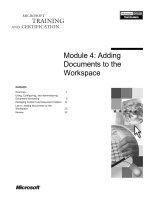Tài liệu The ASP Timeline doc
Bạn đang xem bản rút gọn của tài liệu. Xem và tải ngay bản đầy đủ của tài liệu tại đây (122.77 KB, 10 trang )
10 Chapter 1 • Introducing ASP.NET
The ASP Timeline
Before looking at ASP.NET, let’s briefly take a look at the short but eventful his-
tory of Active Server Pages to see how we got to where we are today:
■
December 1995 Microsoft makes a dramatic U-turn and announces
that their whole product lineup will be refocused to embrace the
Internet. Up until this point they had largely ignored the Internet
market and had fallen dangerously behind the competition.
■
February 1996 Microsoft releases Internet Information Server to the
public for free download. Microsoft spokespeople claim that the server
offers a four-fold increase in performance over Netscape Netsite server.
IIS includes ISAPI and IDC technologies.
■
With the release of Windows NT 4, IIS version 2 is bundled, while
IIS 1 is available for Windows NT 3.51.
■
October 1996 Microsoft releases the public beta for IIS 3 as an
optional upgrade to IIS 2.The major change with this version is the
inclusion of a new development environment called Active Server Pages,
formerly known under its project name of “Denali.” As part of their
public relations campaign, Microsoft claims they are beating Netscape 2-
1 in the server market. IIS no longer supports MIPS and NT 3.51.
■
August 1997 Microsoft releases ASP 2 with IIS 4. IIS now includes the
Microsoft Management Console (MMC) to make administering the
server more straightforward, and the SMTP server is now bundled,
having previously been a part of the Commercial package. IIS and ASP
are now tightly integrated with Microsoft Transaction Server, and this is
seen as a real step forward in making the platform a credible choice for
large-scale deployment.
■
1998–2000 Microsoft started releasing incremental versions of the lan-
guage Scripting Engines, adding language features and functionality
without the need for full ASP version updates, such as the addition of
Regular Expressions for VBScript programmers.
■
With the release of Windows 2000 with IIS 5, Active Server Pages 3
became available. ASP 3 allowed for server-side redirects, better error
support, ADO 2.5 with support for XML, and caching of compiled
code. IIS 5 enabled the administrator to finely separate processes to
prevent crashing of the server.
www.syngress.com
166_ASPNET_01.qxd 11/21/01 2:39 PM Page 10
Introducing ASP.NET • Chapter 1 11
■
July 2000 .NET makes their first public announcement, revealing their
new C# language, promising to deliver better functionality and flexi-
bility than ever before, and promising support for a wide variety of
Internet standards.
Reviewing the Basics
of the ASP.NET Platform
Microsoft has done a great job of bringing ASP and their older languages into
the twenty-first century with .NET. ASP.NET, using VB.NET, is now a full-
fledged object-oriented Web application development platform, and has seen
many improvements; but the past legacy languages should not hold back a new
initiative as massive as .NET, so Microsoft developed a new headline-grabbing
language for the .NET Framework, called C#.
C# was built from scratch as the .NET language.While it has features familiar
to C programmers, and it has some of the great RAD features so beloved by
Visual Basic programmers, it is completely new. Some have said that C# is
Microsoft’s “me too” language to compete with Sun’s Java.
If Microsoft does one thing well, that is building developer tools, (remember,
the product that first put Microsoft on the map was their version of Basic), and
C# with Visual Studio.NET certainly lives up to expectations. C# is a truly
modern language with all the features you could wish for, such as full object-ori-
entation (unlike the C++ bolted-on approach), automatic memory management,
and housekeeping.
The following are some key points about ASP.NET:
■
ASP.NET is a key part of the wider Microsoft .NET initiative,
Microsoft’s new application development platform.
■
.NET is both an application architecture to replace the Windows DNA
model and a set of tools, services, applications and servers based around
the .NET Framework and common language runtime (CLR).
■
Rather than just being ASP 4 or an incremental upgrade, ASP.NET is a
complete rewrite from the ground up, using all the advanced features
.NET makes available.
■
ASP.NET can take advantage of all that .NET has to offer, including
support for around 20 or more .NET languages from C# to Perl.NET,
and the full set of .NET Framework software libraries.
www.syngress.com
166_ASPNET_01.qxd 11/21/01 2:39 PM Page 11
12 Chapter 1 • Introducing ASP.NET
■
Web applications written in ASP.NET are fast, efficient, manageable,
scalable, and flexible, but, above all, easy to understand and to code!
■
Components and Web applications are all compiled .NET objects
written in the same languages, and they offer the same functionality, so
no need to leave the ASP environment for purely functional reasons.
■
You’ll have less need for third-party components.With a few lines of
code, ASP.NET can talk to XML, serve as or consume a Web service,
upload files,“screen scrape” a remote site, or generate an image.
Utilizing the Flexibility of ASP.NET
With the .NET Framework and ASP.NET, Microsoft has not just shown itself to
be a contender in Web development technologies, but many commentators also
believe Microsoft has taken the lead. ASP.NET is well equipped for any task you
want to put to it, from building intranets to e-business or e-commerce mega-
sites. Microsoft has been very careful to include the functionality and flexibility
developers will require, while maintaining the easy-to-use nature of ASP.
■
With ASP.NET you now have a true choice of languages. All the .NET
languages have access to the same foundation class libraries, the same
type of systems, equal object orientation and inheritance abilities, and
full interoperability with existing COM components.
■
You can use the same knowledge and code investment for everything
from Web development to component development or enterprise sys-
tems, and developers do not have to be concerned about differences in
APIs or variable type conversions, or even deployment.
■
ASP.NET incorporates all the important standards of our time, such as
XML and SOAP, plus with ADO.NET and the foundation class libraries,
they are arguably easier to implement than in any other technology,
including Java.
■
An ASP.NET programmer still only needs a computer with Notepad
and the ability to FTP to write ASP code, but now with the .NET
Framework command-line tools and the platform’s XML-based configu-
ration, this is truer than before!
■
Microsoft has included in the .NET Framework an incredibly rich fea-
ture set of library classes, from network-handling functions for dealing
with Transmission Control Protocol/Internet Protocol (TCP/IP) and
www.syngress.com
166_ASPNET_01.qxd 11/21/01 2:39 PM Page 12
Introducing ASP.NET • Chapter 1 13
Domain Name System (DNS), through to XML data and Web Services,
to graphic drawing.
■
In the past, the limitations of ASP scripting meant components were
required for functionality reasons, not just for architectural reasons.
ASP.NET has access to the same functionality and uses the same lan-
guages in which you would create components, so now components are
an architectural choice only.
■
A .NET developer is shielded from changes in the underlying operating
system and API, as the .NET technologies deal with how your code is
implemented; and with the Common Type System, you don’t have to
worry whether the component you are building uses a different imple-
mentation of a string or integer to the language it will be used in.
Converting Code into Multiple Languages
As supplied by Microsoft, ASP.NET and the .NET Framework consist of three
main languages: JScript.NET,VB.NET, and C#. Other vendors have available or
have announced many more, such as Perl.NET, COBOL.NET, and a version of
Python.
www.syngress.com
Deploying ASP.NET Applications
In previous ASP versions, deploying your application required careful plan-
ning, particularly if the system was large and complex. This was because
of various factors, including the requirement to upload, install, and reg-
ister components, necessitating stopping and starting the Web server and
ensuring that you had the correct version. You had to configure Web
servers through Microsoft Management Console, ADSI, or command-line
tools, also often requiring you to stop and restart services.
With ASP.NET, this has all been simplified. ASP files, components,
and configuration options are all files that you upload together. You do
not need to register components, and you can specify nearly all config-
uration changes using XML format text files. ASP.NET has even simplified
software version dependencies by enabling you to host several versions
of a component on the same system.
Developing & Deploying…
166_ASPNET_01.qxd 11/21/01 2:39 PM Page 13
14 Chapter 1 • Introducing ASP.NET
JScript has been updated to be a full-fledged language and to take account of
the object-oriented nature of .NET. Experienced JScript developers should feel
very at home and be pleasantly surprised at the new additions.
VB.NET replaces VBScript support, but is similar enough in operation that it
isn’t too steep a learning curve for VBScript programmers, and as with JScript
above, it provides you with full access to all that .NET has to offer, including, for
the first time, full object orientation.
C# has been (perhaps unfairly) described as J++ mark 2.There is more to it
than that. C# is effectively C++ built from scratch.The problems with C++ are
well documented, so there is no need to go into them here, but suffice it to say
that in C++, object orientation was an optional bolted-on afterthought, whereas
in C#, it was built in from the ground up.
All the functionality and support of the .NET Framework is available to any
of the .NET languages, and in addition, objects written under one language can
be used, inherited, and extended under any of the others.This is a very powerful
concept and introduces the idea of language independence.This is achieved
through the Common Language Runtime technology.
The CLR takes your .NET language code and converts it into an interme-
diate language (Microsoft Intermediate Language [MSIL]), and this intermediate
language is then compiled to target machine-specific binary code.The
Intermediate Language specification is one of the many .NET technologies that
have been submitted to standards bodies, and several projects are under way to
transport the software over to non-windows platforms, such as Mono and
Portable.NET in the open source community, and to developments from Corel
and Borland.
Comparing Improvements in
ASP.NET to Previous ASP Models
The first difference an experienced ASP developer will notice is that VBScript
support has been dropped in favor of VB.NET.This is not as much of a hurdle as
it sounds like, as the syntax is quite similar, and VB.NET is a full-fledged language
and so provides a lot richer environment than VBScript ever could.
As described above, all ASP.NET languages are object oriented, event driven,
and server compiled.This brings many benefits, especially where improvements
were needed most, namely performance, stability, scalability, and manageability.
With Classic ASP, you pretty much had to code your whole application from
scratch. ASP.NET has several labor-saving additions to make life easier.Web forms
www.syngress.com
166_ASPNET_01.qxd 11/21/01 2:39 PM Page 14









